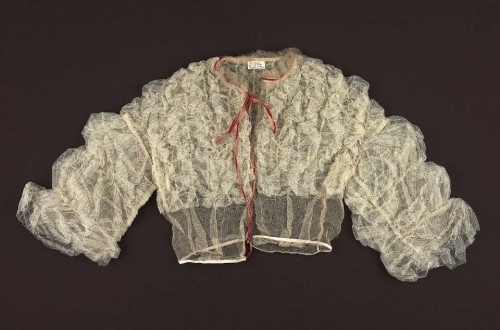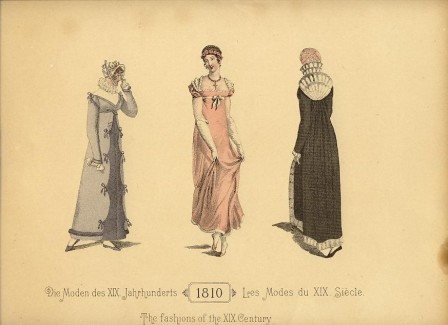I ran across this object recently, and was most intrigued:
The MFA Boston describes it as:
A guimpe of gathered and puffed white net, high round neck, open down front elbow length sleeves, foundation of tarlatan covered with net, white tulle ruching around neck held in place with narrow coral velvet ribbon.
While interesting, this still doesn’t explain what a guimpe is (other than a sort of lacy blouse thing which you obviously had to wear under or over another garment, which you can tell from the photo), or what you do with it.
So I did a little research.
Apparently a guimpe is a short blouse worn under a pinafore/jumper dress, or a fill in for a low-cut dress.
It’s very similar to a chemisette or dickey. It was a word that was particularly common in the mid-late 19th century, and it comes from the Old French word for wimple, which is why the white thing that nuns wear around their necks/heads are also sometimes called guimpes.
Here is a very early gown with a what the fashion notes describe as a fichu-guimpe:
The notes say
1810.
1. Redingote en merinos garnie en brandebourgs. Fiche-guimpe. Capote a l’invisible garnie de roses.
2. Robe de tulle rose double de satin rose; garnie de tulle blanc. Coiffure de roses.
3. Redingote de velours a Coqueluchon, garnie de petit gris. Capote en rubans.
Here is what a more dickey-like guimpe looks like:
There we go. Now I know what a guimpe is. And so do you. Unless you already knew, and it’s just one of those basic words that everyone except me managed to know.




Neat to see the research. I have, in fact, an original Edwardian guimpe of net, the neck collar held up with little crimped metal stays.
You can find out a lot about guimpes in the Edwardian Modiste by Frances Grimble, too.
Very best,
Natalie in KY
Do you know how to pronounce guimpe? My Old French is not up to par.
I came across it in my research with the Sisters of Mary’s habits. I believe it has it’s origin’s from medieval times – and that the nun’s habits just stayed similar to that form of dressing, or at least with the naming of the parts to their outfits.
I have heard it pronounced close to ‘gimp’ but the Sisters pronounced it more like ‘gamp’…..
The wimple is more the part that covers the chin and neck, the coif the part that covers the hair, and the guimpe is for the neck and chest area….kinda… (and then don’t start me on the dimity, and the domino…..)
How interesting! I would have assumed it was the proper spelling of gimp, as in an edging braid. I wonder if the two things are related through some french logic that escapes us! Sacre Bleu!
the wimple originally was introduced to the nuns between 12th and 14th century because it was also part of the typical widows weeds – wich were always closely related to nuns habits, because they were often founded by widows and many widows entered a convent forever or till they are going to be remarried … this was also called a ‘barbe’ later.
It depends on the social rank of the widow how high the barbe was pulled up over the chin or if it was worn beneath it. There is a nice brass in Westminster on the tomb of Eleanor de Bohun wich shows a high version of this barbe…
That guimpe is such a remarkable survival, given how brittle tulle of this era can get…
(And this is a test comment to see how commenting on your blog works…)
I remember my mother having what she called gimps in the 50’s – a little triangular piece of fabric that fastened either side to bra straps. It was used to fill in any neckline she considered too low for decency or warmth. Astonishingly I have just seen them in Wal-Mart in the USA – three in a packet. My impression was they were called gimps because generally they were made of gimp lace, but maybe they were called gimps because they were, themselves, trimmings to a garment? As with all the things from her time and earlier, which interest me now, it is too late to ask!!
Noun
guimpe
Gimp; a narrow flat braid or reinforced cord of fabric used for ornamental trimming.
A kind of short, high-necked blouse with sleeves of the late Victorian era, designed to be worn under a low-cut dress, jumper, or pinafore dress.
A kind of short chemisette or yoke insert made of lace, embroidery, or the like, worn with a low-necked dress.
A wimple; a wide, stiffly starched cloth that covers the neck and shoulders, as part of the habit of nuns of certain orders.
Marilyn
letoutparis.blogspot.com
thank you for explaining what a guimpe is.. I looked for it in a Webster’s New World Dictionary, and was not found. I have a dress pattern for a 14″ composition doll and the bodice and sleeves were called a guimpe. I just had to check it out. Thanks for being here.